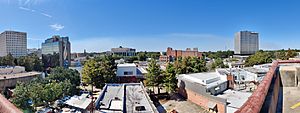Lafayette metropolitan area, Louisiana facts for kids
Quick facts for kids
Lafayette
Vermilionville
|
||
|---|---|---|
| Lafayette, LA metropolitan statistical area | ||

Lafayette, Louisiana skyline, 2021
|
||
|
||
| Nickname(s):
Hub City
|
||
| Country | United States | |
| State | Louisiana | |
| Principal city | Lafayette | |
| Other cities | ||
| Population
(2020)
|
||
| • Metro | 478,384 | |
| Time zone | UTC-6 (CST) | |
| • Summer (DST) | UTC-5 (CDT) | |
| Website | http://www.lafayettela.gov/ | |
| Named for Gilbert du Motier, marquis de La Fayette | ||
Lafayette is a large area in Louisiana, USA. It's also known as the Lafayette metropolitan statistical area. This area is the third biggest in the state. It's located in the south-central part of Louisiana, in a region called Acadiana.
In 2020, about 478,384 people lived in the Lafayette area. This makes it one of the fastest-growing places in Louisiana. Back in 2010, its population was much smaller, with 273,738 people. The main city in this area is Lafayette, which is the biggest center for business and culture in Acadiana.
Many well-known companies have a presence in the Lafayette area. These include Amazon, IberiaBank, and Rouses Market. The area is also home to the University of Louisiana at Lafayette.
Contents
Exploring Lafayette's Geography
The Lafayette metropolitan area covers a large space, about 3,408.5 square miles (8,828 square kilometers). To give you an idea, this area is bigger than the entire state of Delaware! It's located in the Acadiana region of Louisiana.
The main parts of the Lafayette area include Lafayette and Saint Martin parishes. Later, Acadia, Iberia, and Vermilion parishes were added. This whole area is near the Gulf Coast of the United States. It's also close to other big cities like Lake Charles and New Orleans. Most of the communities in Lafayette are not very high above sea level.
Communities in the Lafayette Area
The Lafayette metropolitan area includes many different towns and cities. Here are some of the main ones:
- Abbeville
- Breaux Bridge
- Broussard
- Carencro
- Crowley
- Delcambre
- Duson
- Eunice
- Erath
- Gueydan
- Henderson
- Jeanerette
- Kaplan
- Lafayette (This is the main city!)
- Loreauville
- Maurice
- New Iberia
- Opelousas
- Parks
- Rayne
- St. Martinville
- Scott
- Youngsville
People Living in Lafayette
The population of the Lafayette metropolitan area has grown quite a bit over the years. In 2010, there were about 273,738 people living there. By 2020, this number had increased to 478,384 people. This growth made Lafayette the third largest metropolitan area in Louisiana.
The people in Lafayette come from many different backgrounds. The main groups include White and African American residents. There are also smaller groups of Asian, Native American, and Hispanic or Latino people. This mix of cultures makes Lafayette a diverse place to live.
Lafayette's Economy and Jobs
The city and parish of Lafayette are very important for the economy of the entire Acadiana region. Many businesses have chosen to set up shop here. Some of the big companies that help the economy include Albertsons, Amazon, CGI, First Horizon Bank, and JP Morgan Chase.
Besides these companies, two important schools also boost the economy: the University of Louisiana at Lafayette and South Louisiana Community College. These schools bring in students and jobs, helping the area grow.
Getting Around Lafayette: Transportation
Lafayette has several ways to get around, making it easy for people to travel.
Air Travel
The main airport for the area is Lafayette Regional Airport. It's located on U.S. Highway 90. From this airport, you can catch flights to major cities like Atlanta, Dallas/Fort Worth, Houston, and Charlotte. A brand new terminal opened at the airport in January 2022, making travel even better.
Roads and Trains
Two major highways, Interstate 10 and Interstate 49, run through the Lafayette area. These are important for driving to other parts of Louisiana and beyond.
You can also travel by train! The Amtrak Sunset Limited train offers service three days a week. You can ride it from New Orleans all the way to Los Angeles, California, with stops in several states. If you want to go to other parts of the country, you can connect to different train lines in New Orleans.
For bus travel, Greyhound has a station downtown. This allows people to travel by bus to many different destinations. Within Lafayette city limits, the Lafayette Transit System provides local bus service.
Local Roads
Many other important roads help people get around Lafayette. These include U.S. Route 90 and U.S. Route 167. Other busy roads like Ambassador Caffery Parkway, Verot School Road, and Johnston Street help connect different parts of the city and surrounding areas.


